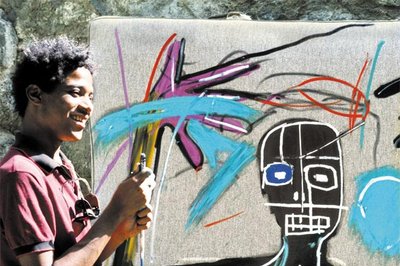Whether or not one appreciates the work of artist Jean-Michel Basquiat, there is no denying his impact in the contemporary art world. A graffiti artist in New York in the late 1970s, Basquiat rose to prominence when his paintings sold to important collectors for huge sums of money. His death, from a drug overdose at 27 in 1988, proved Madonna right when she called the artist “too fragile for this world.”
Tamra Davis’ elegiac documentary, “Jean-Michel Basquiat: The Radiant Child,” provides a series of personal reflections on the artist from friends, lovers, critics and collectors who knew and admired him. Unlike fellow artist Julian Schnabel’s 1996 hagiography-as-biopic “Basquiat,” this film captures its subject’s mercurial personality in rare interview footage the director shot more than two decades ago. Anecdotes that provide insight to Basquiat’s life and work flesh out this portrait of the young artist as tragic figure.
Davis shows how Basquiat ran away from his Brooklyn home at 17 and lived on the streets of New York City alongside the artists who inspired him. Andy Warhol was one of those mentors, and a famous scene of Basquiat selling postcards to a lunching Warhol is recounted here as a testament to his efforts to become famous.
“Jean-Michel Basquiat” charts the artist’s rise after this moment, when his work was displayed at the 1980 Times Square Art Show along with his contemporaries, such as queer artist Keith Haring. Basquiat’s paintings captured the imagination of gay poet/art critic René Ricard, who published the influential article, “The Radiant Child,” in Artforum magazine. This piece helped establish Basquiat in the art world. Ricard is interviewed in the film about finding an artist he could follow from the start of his career.
Davis did an excellent job, seamlessly weaving together interviews, photographs and footage of Basquiat with his works of art. Copious amounts of the artist’s impressive catalog are on display here. Not only is the amount of art and the speed in which they were produced impressive, but the elegance of the work is exciting.
Another strength of the film is that Davis gives viewers context for Basquiat’s work by providing a succint art-history lecture. It cites the artist’s popular-culture references in his work; his homage to Picasso, Van Gogh and other painters; how Basquiat was influenced by celebrities; and how his work commented on issues such as race. His “Black King” series, it is explained, was created because the “world doesn’t celebrate enough black kings.”
“Jean-Michel Basquiat” also addresses the artist’s struggles. He had father issues — Basquiat tried throughout his life to impress his dad with his success. There was also escalating drug use, especially after his rock-star status in the art world started to decline. The negative critical reception of a show he and Warhol did together — in what was Basquiat’s bid for greater respect — was painful. Likewise, Warhol’s subsequent death caused Basquiat to sink into depression.
Davis’ film presents the idea that Warhol had a crush on Basquiat, and some of the most fascinating video footage in the documentary features the two artists chatting playfully in an interview. Other comments — from Schnabel acknowledging the love these two artists had for each other or an interview with Basquiat’s girlfriend Suzanne Mallouk, who mentions being a “third wheel” in the Basquiat-Warhol relationship, are interesting tidbits.
Yet viewers looking for gossipy revelations will be disappointed. There is little of the artist’s sexuality — his penchant for white lovers, his affair with Madonna or his rumored bisexuality. Perhaps Davis felt protective of her subject’s personal life, given her connection to him.
Despite this minor drawback, “Jean-Michel Basquiat” is still a worthwhile film. Davis has created a jazzy, fast-paced depiction of Basquiat’s world, and how his quest to make art and become famous led to his untimely demise. The film leaves no question about Basquiat’s talent. It just may leave viewers wanting to know more.
“Jean-Michel Basquiat: The Radiant Child” opens Sept. 17 at Ritz Theaters.

